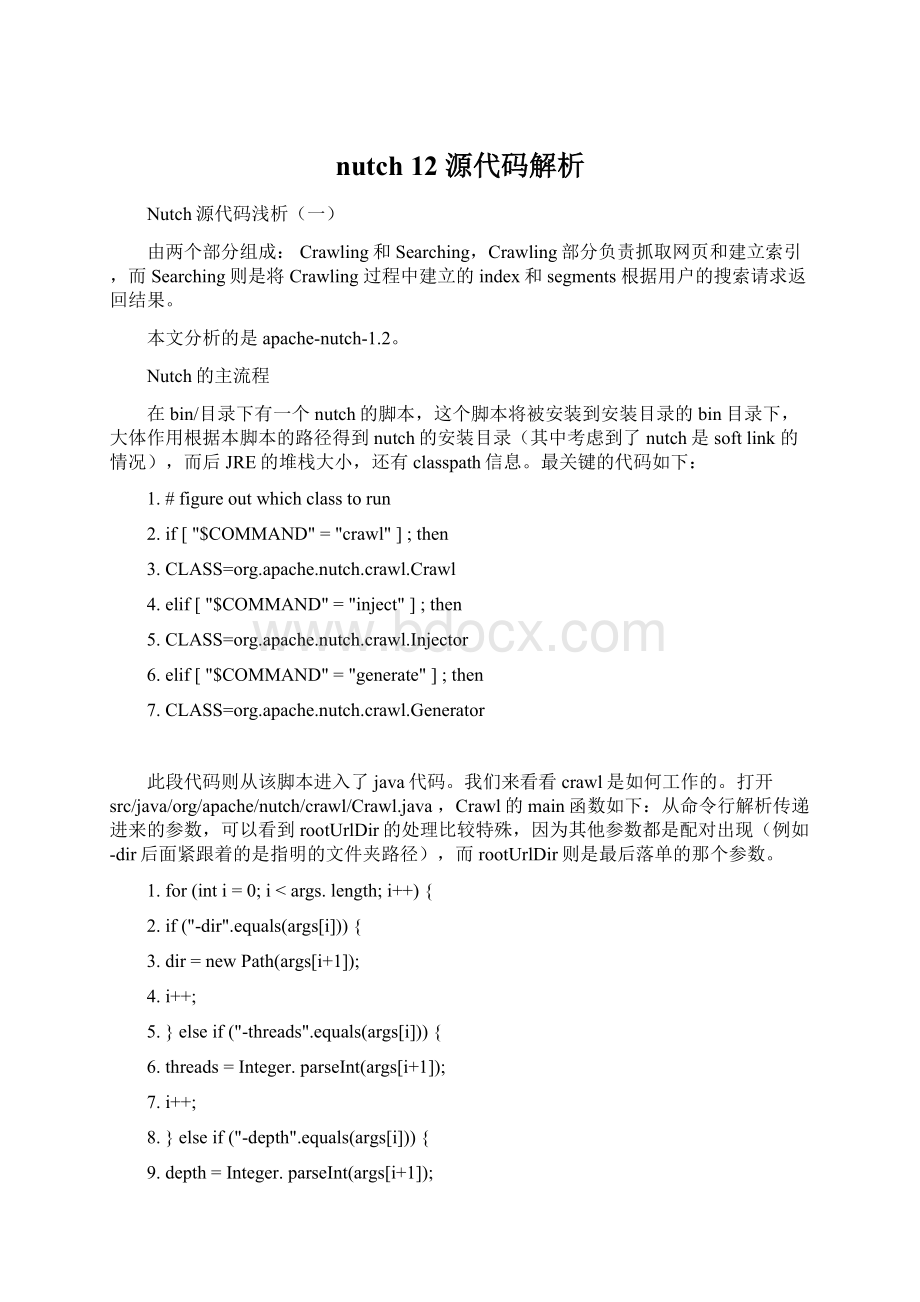nutch 12 源代码解析Word文档格式.docx
《nutch 12 源代码解析Word文档格式.docx》由会员分享,可在线阅读,更多相关《nutch 12 源代码解析Word文档格式.docx(29页珍藏版)》请在冰豆网上搜索。

.equals(args[i])){
3.dir=newPath(args[i+1]);
4.i++;
5.}elseif("
-threads"
6.threads=Integer.parseInt(args[i+1]);
7.i++;
8.}elseif("
-depth"
9.depth=Integer.parseInt(args[i+1]);
10.i++;
11.}elseif("
-topN"
12.topN=Integer.parseInt(args[i+1]);
13.i++;
14.}elseif("
-solr"
15.indexerName="
solr"
;
16.solrUrl=StringUtils.lowerCase(args[i+1]);
17.i++;
18.}elseif(args[i]!
=null){
19.rootUrlDir=newPath(args[i]);
20.}
21.}
下面就开始进入正题了:
1.首先调用Injector的inject函数将rootUrlDir目录下的所有文件中的网址注入到crawlDb数据库。
2.根据指定的抓取深度,循环做以下三件事:
•调用Generator的generate函数,产生URL的fetchlist,并放在一个或者多个segments中。
•调用Fetcher的fetch函数,获取segs[0]所制定的segement,并Parsing,parsing操作可以是集成在了fetch这一步,也可以是单独下一步来做。
这儿值得注意的是,只取了第一个seg,而数组中有可能有多个seg,没有fetch。
•调用CrawlDb的update函数,将segments中的fetch和parsing的数据合并到数据库(crawlDb)中。
这里取的是segs数组,我觉得这儿可能是有问题的。
3.建立并合并索引。
1.//initializecrawlDb
2.injector.inject(crawlDb,rootUrlDir);
3.inti;
4.for(i=0;
depth;
i++){//generatenewsegment
5.Path[]segs=generator.generate(crawlDb,segments,-1,topN,System
6..currentTimeMillis());
7.if(segs==null){
8.LOG.info("
Stoppingatdepth="
+i+"
-nomoreURLstofetch."
);
9.break;
10.}
11.fetcher.fetch(segs[0],threads,org.apache.nutch.fetcher.Fetcher.isParsing(conf));
//fetchit
12.if(!
Fetcher.isParsing(job)){
13.parseSegment.parse(segs[0]);
//parseit,ifneeded
14.}
15.crawlDbTool.update(crawlDb,segs,true,true);
//updatecrawldb
16.}
17.if(i>
0){
18.linkDbTool.invert(linkDb,segments,true,true,false);
//invertlinks
19.//index,dedup&
merge
20.FileStatus[]fstats=fs.listStatus(segments,HadoopFSUtil.getPassDirectoriesFilter(fs));
21.if(isSolrIndex){
22.SolrIndexerindexer=newSolrIndexer(conf);
23.indexer.indexSolr(solrUrl,crawlDb,linkDb,
24.Arrays.asList(HadoopFSUtil.getPaths(fstats)));
25.}
26.else{
27.
28.DeleteDuplicatesdedup=newDeleteDuplicates(conf);
29.if(indexes!
30.//Deleteoldindexes
31.if(fs.exists(indexes)){
32.LOG.info("
Deletingoldindexes:
"
+indexes);
33.fs.delete(indexes,true);
34.}
35.//Deleteoldindex
36.if(fs.exists(index)){
37.LOG.info("
Deletingoldmergedindex:
+index);
38.fs.delete(index,true);
39.}
40.}
41.
42.Indexerindexer=newIndexer(conf);
43.indexer.index(indexes,crawlDb,linkDb,
44.Arrays.asList(HadoopFSUtil.getPaths(fstats)));
45.
46.IndexMergermerger=newIndexMerger(conf);
47.if(indexes!
48.dedup.dedup(newPath[]{indexes});
49.fstats=fs.listStatus(indexes,HadoopFSUtil.getPassDirectoriesFilter(fs));
50.merger.merge(HadoopFSUtil.getPaths(fstats),index,tmpDir);
51.}
52.}
53.
54.}else{
55.LOG.warn("
NoURLstofetch-checkyourseedlistandURLfilters."
56.}
57.if(LOG.isInfoEnabled()){LOG.info("
crawlfinished:
+dir);
}
Nutch源代码浅析
(二)(Crawl中Inject的工作流程)
Inject操作的入口函数在org.apache.nutch.crawl.Injector中,main函数调用run函数,最后进入inject函数:
1、产生一个以随机数结尾的文件夹tempDir。
2、运行一个Hadoop的MapRedJOb(sortJob),将urls目录下的所有网址读出,并保存到3、OutputCollector<
Text,CrawlDatum>
对象中,而后将该对象序列化到tempDir文件夹下。
3、运行另外一个Hadoop的MapRedJob(mergeJob),将tempDir新产生数据和crawlDb已有的老数据合并,合并过程如果有某些网址新旧冲突,将保留已有的老数据,最终结果将保存于crawlDb下的一个随机数命名的文件夹newCrawlDb中(有别于1中的名称)。
4、重命名crawlDb下的“current”文件夹为“old”,如果“old”文件夹已经存在,将删除之,而后将newCrawlDb文件夹重名为"
current"
,删除tempDir。
publicvoidinject(PathcrawlDb,PathurlDir)throwsIOException{
SimpleDateFormatsdf=newSimpleDateFormat("
yyyy-MM-ddHH:
mm:
ss"
longstart=System.currentTimeMillis();
if(LOG.isInfoEnabled()){
LOG.info("
Injector:
startingat"
+sdf.format(start));
crawlDb:
+crawlDb);
urlDir:
+urlDir);
//默认会在当前文件夹产生类似于inject-temp-853856658的目录,数位为随机数
PathtempDir=
newPath(getConf().get("
mapred.temp.dir"
"
."
)+
/inject-temp-"
+
Integer.toString(newRandom().nextInt(Integer.MAX_VALUE)));
//maptextinputfiletoa<
url,CrawlDatum>
file
Convertinginjectedurlstocrawldbentries."
JobConfsortJob=newNutchJob(getConf());
sortJob.setJobName("
inject"
//讲命令行中传入的urls目录作为sortJob的输入,其后将会读取其中的内容
FileInputFormat.addInputPath(sortJob,urlDir);
//InjectMapper会根据urls目录下所有文件的内容,产生OutputCollector<
Text,CrawlDatum>
对象。
//其中Text表示url,而CrawlDatum对象则存放着url相关的状态信息,稍后会详加介绍。
//有两种方法设置Mapper,一中通过setMapperClass,另一种通过setMapRunnerClass,后法在Fetcher中有使用,
//优点可以以线程启动
sortJob.setMapperClass(InjectMapper.class);
//将输出的结构存放的tempDir目录下
FileOutputFormat.setOutputPath(sortJob,tempDir);
//采用Sequence的方式存储文件
sortJob.setOutputFormat(SequenceFileOutputFormat.class);
//设置Key和Value的Class,和InjectMapper的map输出OutputCollector<
相对应的
//对所有Hadoop中的Job都必须符合这一规则。
sortJob.setOutputKeyClass(Text.class);
sortJob.setOutputValueClass(CrawlDatum.class);
sortJob.setLong("
injector.current.time"
System.currentTimeMillis());
//调用Hadoop中的MapRed实现,运行sortJob
JobClient.runJob(sortJob);
//mergewithexistingcrawldb
Merginginjectedurlsintocrawldb."
//将根据urls目录下产生的临时数据tempDir合并到crawlDb已有的数据中
//mergeJob的具体设置在CrawlDb.createJob()中实现
JobConfmergeJob=CrawlDb.createJob(getConf(),crawlDb);
FileInputFormat.addInputPath(mergeJob,tempDir);
//调用InjectReducer中的reduce函数,实现合并
mergeJob.setReducerClass(InjectReducer.class);
JobClient.runJob(mergeJob);
//备份crawlDb中的老数据,将新的结果替换为新的数据
CrawlDb.install(mergeJob,crawlDb);
//cleanup
//清楚中间数据
FileSystemfs=FileSystem.get(getConf());
fs.delete(tempDir,true);
longend=System.currentTimeMillis();
finishedat"
+sdf.format(end)+"
elapsed:
+TimingUtil.elapsedTime(start,end));
}
而后我们来看看InjectMapper是如何实现map操作的,会发现,起始url可以有两个参数,并且在此函数中引入了urlfilter和scorefilter
//key在此没用到,而value中这是从urls文件下文件中读出的一行字符串
//输出会追加到output中,Text是url,而CrawlDatum为该url想对应的状态等信息
publicvoidmap(WritableComparablekey,Textvalue,
OutputCollector<
output,Reporterreporter)
throwsIOException{
Stringurl=value.toString();
//valueislineoftext
if(url!
=null&
&
url.trim().startsWith("
#"
)){
/*Ignorelinethatstartwith#*/
return;
//在url文件中描述一个url时,需要以其网址开头,需要以tab键隔开,
//目前支持在其后追加两种参数(可同时存在),"
nutch.score"
和"
nutch.fetchInterval"
,
//这样我们可以根据需要对某个url单独设置score和fetchInterval,
//这两个参数将会作为metadata存入CrawlDatum对象中
//iftabs:
metadatathatcouldbestored
//mustbename=valueandseparatedby/t
floatcustomScore=-1f;
intcustomInterval=interval;
Map<
String,String>
metadata=newTreeMap<
();
if(url.indexOf("
/t"
)!
=-1){
String[]splits=url.split("
url=splits[0];
for(ints=1;
s<
splits.length;
s++){
//findseparationbetweennameandvalue
intindexEquals=splits[s].indexOf("
="
if(indexEquals==-1){
//skipanythingwithouta=
continue;
Stringmetaname=splits[s].substring(0,indexEquals);
Stringmetavalue=splits[s].substring(indexEquals+1);
if(metaname.equals(nutchScoreMDName)){
try{
customScore=Float.parseFloat(metavalue);
catch(NumberFormatExceptionnfe){}
elseif(metaname.equals(nutchFetchIntervalMDName)){
customInterval=Integer.parseInt(metavalue);
elsemetadata.put(metaname,metavalue);
url=urlNormalizers.normalize(url,URLNormalizers.SCOPE_INJECT);
//注意,这就是urlfilter的入口点,在inject到crawlDb之前需要经历urlfilter的筛选,
//如果不符合筛选条件,将返回null,对此url将不做后续的工作
url=filters.filter(url);
//filtertheurl
}catch(Exceptione){
if(LOG.isWarnEnabled()){LOG.warn("
Skipping"
+url+"
:
"
+e);
url=null;
=null){//ifitpasses
value.set(url);
//collectit
CrawlDatumdatum=newCrawlDatum(CrawlDatum.STATUS_INJECTED,customInterval);
datum.setFetchTime(curTime);
//nowaddthemetadata
Iterator<
String>
keysIter=metadata.keySet().iterator();
while(keysIter.hasNext()){
Stringkeymd=keysIter.next();
Stringvaluemd=metadata.get(keymd);
datum.getMetaData().put(newText(keymd),newText(valuemd));
if(customScore!
=-1)datum.setScore(customScore);
elsedatum.setScore(scoreInjected);
//注意,这儿是scorefilter的入口点
scfilters.injectedScore(value,datum);
}catch(ScoringFilterExceptione){
if(LOG.isWarnEnabled()){
LOG.warn("
Cannotfilterinjectedscoreforurl"
+url
+"
usingdefault("
+e.getMessage()+"
)"
//将结果添加到output中
output.collect(value,datum);
再看看InjectReducer是如何实现reduce的,简而言之,新旧合并,新旧冲突时,保留老的
//reduce顾名思义就是了处理一对多的情况,为了处理新老之间的合并而已,
//所以从函数的入参可以看出一些端倪,一个key,但一组values,输出依然是
//OutputCollector<
publicvoidreduce(Textkey,Itera